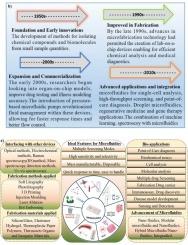微流体中微/纳米通道技术的创新生物医学应用
IF 4.9
2区 化学
Q1 CHEMISTRY, ANALYTICAL
引用次数: 0
摘要
微流控装置的开发是生物研究领域的一项重大突破。这些装置被称为分析微系统,具有高灵敏度,善于分析复杂的生物材料。微流体设备在微米和纳米尺度上发挥作用,利用精确设计的微通道来分离、分析和改变流体和颗粒的行为,应用范围广泛,包括药物开发、环境监测、生物危害检测和临床诊断。人们对微流体技术的兴趣与日俱增,这揭示了该技术所用材料的众多优势。通过利用微尺度流体的独特特性,这些设备提高了自动化、控制和高通量处理能力,有可能取代一些传统的生物分析和诊断方法。此外,微流体设备往往更具成本效益,所需的生物测定时间更短,使用的化学品和样品量更少。这使它们成为生物技术高级研究的高效解决方案。这篇综述文章重点介绍了微流体设备制造中各种材料(包括无机和有机材料)的兼容性、优点和应用。我们重点介绍了通过集成先进功能化或改性方法的混合制造技术实现的微/纳米通道性能提升。此外,我们还讨论了微流控特定应用的最新进展,包括与拉曼光谱、质谱和光学检测技术的整合,以增强生物医学应用和传感能力。本文章由计算机程序翻译,如有差异,请以英文原文为准。

Innovative biomedical applications of micro/nano channel technologies in microfluidics
The development of microfluidic devices represents a major breakthrough in biological research. These devices, referred to as analytical microsystems, are engineered for high sensitivity and are adept at analyzing complex biological materials. This innovation has significantly advanced biotechnology, allowing researchers to perform more accurate and efficient analyses of biological samples.Microfluidic devices function at the micron and nanoscale, utilizing precisely designed micro-channels to separate, analyze, and modify the behaviour of fluids and particles across various applications, including drug development, environmental monitoring, biohazard detection, and clinical diagnostics. The increasing interest in microfluidics has revealed numerous advantages associated with the materials used in this technology. By harnessing the distinct properties of fluids at the micro scale, these devices improve automation, control, and high-throughput processing capabilities, potentially replacing some traditional biological analytical and diagnostic methods.Moreover, microfluidic devices tend to be more cost-effective, require shorter bioassay times, and utilize smaller quantities of chemicals and sample volumes. This makes them a highly efficient solution for advanced research in biotechnology. This review article focuses on the compatibility, benefits, and applications of various materials—both inorganic and organic material fabrication of microfluidic devices. We highlight the enhanced performance of micro/nano channels achieved through hybrid manufacturing techniques that integrate advanced functionalization or modification methods. Additionally, we discuss recent advancements in specific applications of microfluidics, including their integration with Raman spectroscopy, mass spectrometry, and optical detection techniques to enhance biomedical applications and sensing capabilities.
求助全文
通过发布文献求助,成功后即可免费获取论文全文。
去求助
来源期刊

Microchemical Journal
化学-分析化学
CiteScore
8.70
自引率
8.30%
发文量
1131
审稿时长
1.9 months
期刊介绍:
The Microchemical Journal is a peer reviewed journal devoted to all aspects and phases of analytical chemistry and chemical analysis. The Microchemical Journal publishes articles which are at the forefront of modern analytical chemistry and cover innovations in the techniques to the finest possible limits. This includes fundamental aspects, instrumentation, new developments, innovative and novel methods and applications including environmental and clinical field.
Traditional classical analytical methods such as spectrophotometry and titrimetry as well as established instrumentation methods such as flame and graphite furnace atomic absorption spectrometry, gas chromatography, and modified glassy or carbon electrode electrochemical methods will be considered, provided they show significant improvements and novelty compared to the established methods.
 求助内容:
求助内容: 应助结果提醒方式:
应助结果提醒方式:


